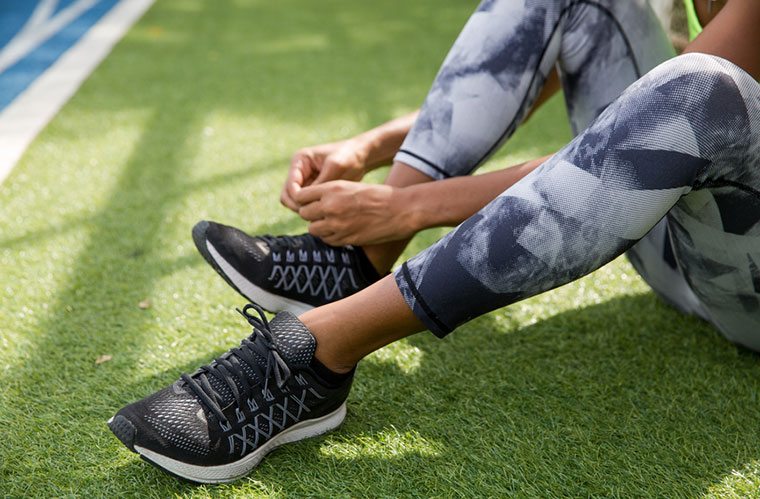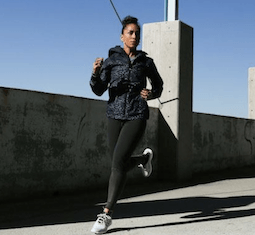It can be daunting to choose from the myriad shoe options available to runners these days. But there are a few helpful pro tips that'll make it easier to narrow down your search—and find the right pair of sneakers for your fave form of running (be it marathons, obstacle races, daily jogs, or pro competitions).
First and foremost? "They must fit comfortably," says sports medicine specialist, Daniel Vigil, MD. "You need a snug shoe around the hind-foot and mid-foot, coupled with an adequately roomed toe box," he says. "The shoe should be about a half to three-quarters of an inch longer than your longest toe."
Sounds obvious, but you'd be surprised how many people sacrifice proper support for bells and whistles that might make your shoes look cool, yet aren't doing your feet any favors, which can lead to more than cramped toes and discomfort. "People have a bad experience with a shoe, and then they'll say they can’t run," says Claire Wood, product developer at New Balance, which recently designed the official apparel (including sneakers) for the New York City Marathon. Her best advice? "You should go to a running specialty store and get a gait analysis done." The test involves putting in a few paces on a treadmill to figure out what happens to your feet when you run—and by extension, the best type of sneakers for your particular needs.
"The old days of having 50 miles on your shoes before the marathon aren't relevant anymore. "
People who've gone through a gait analysis typically fall into one of three categories: overpronator, neutral, or hyper-subinator. Overpronation is associated with flat feet. This foot shape can cause the impact of running to pass on to the legs, knees, hips, and spine. "Overpronators require a motion-control shoe, which has built-in arch support and prevents the foot from rolling over in an inward fashion," says podiatrist and orthopedic surgeon Dr. Yolanda Ragland.

{{post.sponsorText}}
Hyper-supinator foot types, meanwhile, are associated with a high arch during weight-bearing. "Due to a lack of shock absorption, hyper-supination may adversely affect other joints in the body like the ankles, knees, hips and spine," Dr. Ragland says. "A hyper-supinator requires a highly cushioned, flexible shoe type." Finally, neutral foot types can wear any shoe they feel is comfortable.
For a second opinion, Dr. Vigil suggests making an appointment for a podiatrist for a more thorough gait analysis than what you'd undergo at a shoe store. Once you know your foot type, the real fun begins—picking out a cool pair of kicks.
Scroll down for more info on how to choose the right running shoe based on foot type, performance requirements, and terrain.

Everyday training
Dr. Vigil recommends picking a sneaker that's "supportive, well-cushioned, comfortable, and a bit heavy." Wood's advice? "Look for a shoe with a foam sole."
Our picks:
1. Overpronator: Nike LunarGlide 9, $120
2. Neutral: New Balance Fresh Foam 1080, $165
3. Hyper-supinator: Under Armour Charged Bandit 3, $80

Racing
"If you're racing or if you're a professional, then you want to minimize weight as much as possible," says Dr. Vigil. This typically means less cushioning, so make sure to save this pair for race days only.
Our picks:
1. Overpronator: Asics Metarun, $250
2. Neutral: Puma Ignite, $110
3. Hyper-supinator: Mizuno Wave Hitogami, $70

Marathon running
"I would advise someone who's training for a marathon to make sure they’re in a performance running shoe—products that are a little higher end," says Wood. "They’re going to have the durability, both mid-sole and upper, to withstand marathon training. I would also suggest that as that person ramps up more mileage, if things do start to ache, that would be a good time to go to a running store and switch out your shoe. The old days of having 50 miles on your shoes before the marathon aren't relevant anymore. We just advise getting a few runs in beforehand."
Our picks:
1. Overpronator: Brooks Adrenaline GTS 17, $90
2. Neutral: Reebok Floatride Run, $150
3. Hyper-supinator: Asics Dynaflyte, $130

Trail running
"For the trail runner, you're gonna want a shoe that is, first off, much more durable—a thicker sole and more padding," says Dr. Vigil. Wood agrees, with a caveat: "If you’re going to be running on intense trails, you should stick to a true trail shoe," she says. "But a lot of off-road running that people do is actually totally fine in a regular running shoe."
Our picks:
1. Overpronator: Salomon Women's XA PRO 3D GTX, $184
2. Neutral: Hoka One Challenger ATR 4, $130
3. Hyper-supinator: Adidas Rockadia Trail Shoes, $52
Get motivated for a run by downloading this playlist. Plus, find out how much mileage you should be clocking each week.
More from the United States of Running
Loading More Posts...


